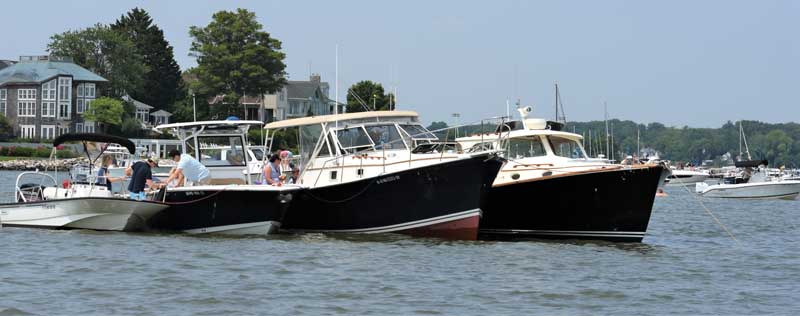Rafting up boats never gets old for socially-oriented boaters, and now that summer’s here, it’s a good time to tie up with friends; just make sure that your floating party doesn’t drift with the tide and wind, or even worse, end up in a tangled mess. Try these tips to make your summer raftup a success.

Start with the mothership, also called the anchor boat or host boat. Usually it’s the largest, heaviest boat. Ideally its captain makes sure its anchor is set and holding before the other boats approach. Try a scope of 10 to one to compensate for the additional weight of the raft.
Who’s really in charge? Defer to the captain of the anchor boat when it comes to determining how many boats the raft can take or if it should break up (for weather or overnight, for example). On the other hand, approaching boat captains should access the raft and make their own determination as to whether they feel it’s safe to join.
If everything looks copasetic, as the rafting boat approaches, it will have lines and fenders ready to be received by the anchor boat, which will have hung fenders only on one side to indicate where the approaching boat should tie up. Approach at a slow speed, otherwise you may need to hit reverse, resulting in prop walk, which will just make the maneuver more challenging. VHF radios come in handy for communication. Once you’re ready to tie up, start with a forward spring line. Add a bow line, stern line, and second spring line.
Use properly tied cleat hitches to ensure that the boats can be untied quickly if needed. Someone should be on both ends of each line as it is loosened. A line dragging in the water can easily get caught up in a propeller. Keep your key in the ignition, so that you’re prepared if the raft has to break up suddenly.
Don’t be ‘that guy.’ Once you’re rafted it’s considered bad form to walk through another boat’s cockpit unless you are invited to do so. Instead, walk over the bows when moving from one boat to another. Boats planning to run a generator should try to keep their exhaust side clear of other boats. If you need to break off early, try your best to be at one end of the raft.
Be prepared for a change in plans. Afternoon thunderstorms are common on the Bay, and it’s safest and easiest to de-raft before the rain and wind hit. Likewise, if there’s any chance of weather coming in overnight, and unless you’re in a very protected anchorage, it’s probably wise to break up the raft before sunset and anchor separately overnight.
Enjoy your boating season and share your raftup photos with us by sending them to [email protected].
These tips come courtesy of Hank Theuns, Rich Tull, and Leigh Seaver, founders of Compass Boating Club of the Chesapeake; Nancie Merritt of the Jeanneau Sailboat Owners club, and Dan Breitenbach, secretary of the Hunter Sailing Association, Station 1.